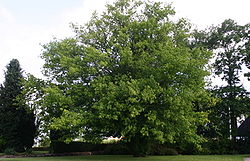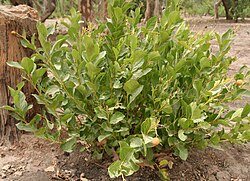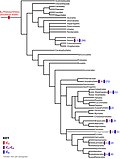The APG III system of flowering plant classification is the third version of a modern, mostly molecular-based, system of plant taxonomy being developed...
47 KB (3,194 words) - 23:22, 30 November 2024
was replaced by the improved APG II in 2003, APG III system in 2009 and APG IV system in 2016. The original APG system is unusual in being based, not...
20 KB (1,426 words) - 19:08, 1 June 2024
(APG). It was published in 2016, seven years after its predecessor the APG III system was published in 2009, and 18 years after the first APG system was...
40 KB (2,558 words) - 15:03, 19 September 2024
published in 1998, and was superseded in 2009 by a further revision, the APG III system. APG II was published as: Angiosperm Phylogeny Group (2003). "An update...
7 KB (651 words) - 08:44, 20 October 2024
three plant families. Under the APG III system, the Asparagaceae contain seven subfamilies, and unlike the APG II system, Asparagaceae was only circumscribed...
27 KB (1,368 words) - 22:11, 23 May 2025
flowering plants. The name is newly accepted in the APG III system of plant taxonomy. APG II system, of 2003, mentions the possibility of recognizing the...
2 KB (193 words) - 16:17, 25 April 2024
mangos and cashews; frankincense and myrrh; mahogany and neem. The APG III system of 2009 includes it in the clade malvids (in rosids, in eudicots) with...
5 KB (407 words) - 02:32, 13 November 2024
flowering plants. The order did not exist in the 2009 APG III system, and was added in the 2016 APG IV system, including two families, Icacinaceae and Oncothecaceae...
2 KB (162 words) - 01:53, 25 May 2025
Angiosperm Phylogeny Group (section APG III (2009))
revisions have been published, in 2003 (APG II), in 2009 (APG III) and in 2016 (APG IV), each superseding the previous system. Thirteen researchers have been...
33 KB (3,527 words) - 15:26, 7 March 2025
potentially containing one family, Dilleniaceae. The APG III system of 2009, like the earlier APG II system of 2003, left the Dilleniaceae unplaced as to order...
2 KB (168 words) - 20:11, 4 February 2025
flowering plants, included within the asterid group of dicotyledons. In the APG III system of 2009, the order includes only two families, Adoxaceae and a broadly...
3 KB (263 words) - 04:40, 8 April 2024
tree. Myrtales include the following nine families, according to the APG III system of classification: Alzateaceae Combretaceae (leadwood family) Crypteroniaceae...
8 KB (672 words) - 21:41, 18 February 2025
Myrsinaceae in 2000 and finally, in 2009 with the introduction of the APG III system, was returned to the subfamily Myrsinoideae within the family Primulaceae...
27 KB (2,643 words) - 03:08, 6 April 2025
APG IV (2016). The botanical name has been recognized by most taxonomists. The APG III system of 2009 recognized the family, as did the APG II system...
3 KB (262 words) - 06:44, 13 December 2024
Liliopsida (section Liliopsida in the Takhtajan system)
Reveal system). subclass Liliidae in the Dahlgren system and the Thorne system (1992) clade monocots in the APG system, the APG II system and the APG III system...
7 KB (675 words) - 22:54, 1 October 2023
"lizard's-tail family". The APG IV system (2016; unchanged from the 2009 APG III system, the 2003 APG II system and the 1998 APG system) assigned it to the order...
4 KB (333 words) - 03:22, 8 April 2024
of the PhyloCode system of phylogenetic nomenclature. While such a clade with a similar circumscription exists in the APG III system, it was not given...
12 KB (1,182 words) - 02:18, 20 April 2025
Angiosperm Phylogeny Group (APG II) both families are unplaced to order, but nevertheless included in the Eurosids I. The APG III system of 2009, however, recognized...
5 KB (334 words) - 16:16, 7 September 2024
Plant taxonomy (section Classification systems)
recent research were published as the APG II system in 2003, the APG III system in 2009, and the APG IV system in 2016. Traditionally, the flowering plants...
15 KB (1,692 words) - 16:57, 3 April 2025
by other taxonomic systems. The APG II system recognized the family as containing a single genus, Pterostemon. The APG III system of 2009, as well as...
1 KB (85 words) - 03:53, 7 April 2024
modern treatment, however, the APG III system of 2009 (unchanged from the 2003 APG II system and the 1998 APG system), places the family in the order...
6 KB (505 words) - 09:34, 18 May 2024
system placed the Turneracids in the order Violales, but it is not currently recognized as a family by the Angiosperm Phylogeny Group in the APG III system...
2 KB (232 words) - 02:54, 8 April 2024
recognized in a number of systems of plant taxonomy. The Illiciaceae is not recognized as a distinct family by the APG III system of plant taxonomy, the...
5 KB (549 words) - 03:28, 8 April 2024
2009 from the purslane family (Portulacaceae) with adoption of the APG III system, to the family Montiaceae. Lewisia rediviva is a low-growing perennial...
13 KB (1,111 words) - 04:54, 3 June 2025
the APG II system (2003) the genus is assigned to family Gunneraceae or to the optionally recognized segregate family Myrothamnaceae. In the APG III system...
5 KB (430 words) - 21:10, 21 January 2025
Pentaphylacaceae are a small family of plants within the order Ericales. In the APG III system of 2009, it includes the former family Ternstroemiaceae. In 2014, the...
2 KB (151 words) - 06:07, 8 April 2024
carried out by members of the Angiosperm Phylogeny Group. In their APG III system of plant classification, they defined Rosales as consisting of the nine...
12 KB (1,058 words) - 13:08, 25 May 2025
as emu bush Myoporum, also known as Boobiala In the APG II system (continued in the APG III system), it is considered to be part of a fairly small family...
2 KB (172 words) - 18:14, 17 March 2025
Nolinoideae is a monocot subfamily of the family Asparagaceae in the APG III system of 2009. It used to be treated as a separate family, Ruscaceae s.l....
7 KB (419 words) - 20:48, 30 November 2024
Restionaceae following APG IV (2016). The family is accepted in the Angiosperm Phylogeny Group's classification system, APG III system, but is not considered...
3 KB (259 words) - 08:55, 30 July 2024

























